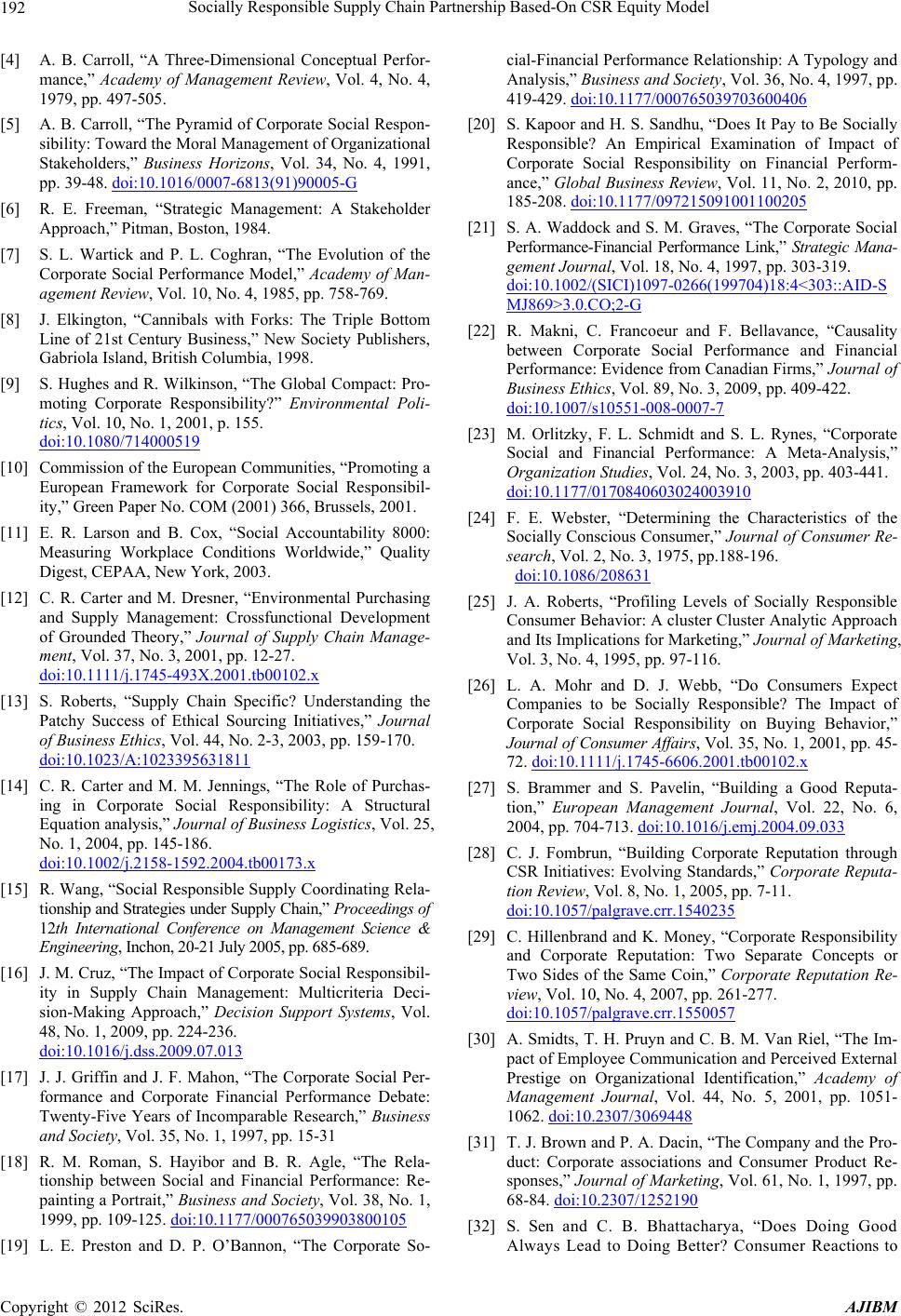
Socially Responsible Supply Chain Partnership Based-On CSR Equity Model
192
[4] A. B. Carroll, “A Three-Dimensional Conceptual Perfor-
mance,” Academy of Management Review, Vol. 4, No. 4,
1979, pp. 497-505.
[5] A. B. Carroll, “The Pyramid of Corporate Social Respon-
sibility: Toward the Moral Management of Organizational
Stakeholders,” Business Horizons, Vol. 34, No. 4, 1991,
pp. 39-48. doi:10.1016/0007-6813(91)90005-G
[6] R. E. Freeman, “Strategic Management: A Stakeholder
Approach,” Pitman, Boston, 1984.
[7] S. L. Wartick and P. L. Coghran, “The Evolution of the
Corporate Social Performance Model,” Academy of Man-
agement Review, Vol. 10, No. 4, 1985, pp. 758-769.
[8] J. Elkington, “Cannibals with Forks: The Triple Bottom
Line of 21st Century Business,” New Society Publishers,
Gabriola Island, British Columbia, 1998.
[9] S. Hughes and R. Wilkinson, “The Global Compact: Pro-
moting Corporate Responsibility?” Environmental Poli-
tics, Vol. 10, No. 1, 2001, p. 155.
doi:10.1080/714000519
[10] Commission of the European Communities, “Promoting a
European Framework for Corporate Social Responsibil-
ity,” Green Paper No. COM (2001) 366, Brussels, 2001.
[11] E. R. Larson and B. Cox, “Social Accountability 8000:
Measuring Workplace Conditions Worldwide,” Quality
Digest, CEPAA, New York, 2003.
[12] C. R. Carter and M. Dresner, “Environmental Purchasing
and Supply Management: Crossfunctional Development
of Grounded Theory,” Journal of Supply Chain Manage-
ment, Vol. 37, No. 3, 2001, pp. 12-27.
doi:10.1111/j.1745-493X.2001.tb00102.x
[13] S. Roberts, “Supply Chain Specific? Understanding the
Patchy Success of Ethical Sourcing Initiatives,” Journal
of Business Ethics, Vol. 44, No. 2-3, 2003, pp. 159-170.
doi:10.1023/A:1023395631811
[14] C. R. Carter and M. M. Jennings, “The Role of Purchas-
ing in Corporate Social Responsibility: A Structural
Equation analysis,” Journal of Business Logistics, Vol. 25,
No. 1, 2004, pp. 145-186.
doi:10.1002/j.2158-1592.2004.tb00173.x
[15] R. Wang, “Social Responsible Supply Coordinating Rela-
tionship and Strategies under Supply Chain,” P roceedi ngs of
12th International Conference on Management Science &
Enginee ri ng, Inchon, 20-21 July 2005, pp. 685-689.
[16] J. M. Cruz, “The Impact of Corporate Social Responsibil-
ity in Supply Chain Management: Multicriteria Deci-
sion-Making Approach,” Decision Support Systems, Vol.
48, No. 1, 2009, pp. 224-236.
doi:10.1016/j.dss.2009.07.013
[17] J. J. Griffin and J. F. Mahon, “The Corporate Social Per-
formance and Corporate Financial Performance Debate:
Twenty-Five Years of Incomparable Research,” Business
and Society, Vol. 35, No. 1, 1997, pp. 15-31
[18] R. M. Roman, S. Hayibor and B. R. Agle, “The Rela-
tionship between Social and Financial Performance: Re-
painting a Portrait,” Business and Society, Vol. 38, No. 1,
1999, pp. 109-125. doi:10.1177/000765039903800105
[19] L. E. Preston and D. P. O’Bannon, “The Corporate So-
cial-Financial Performance Relationship: A Typology and
Analysis,” Business and Society, Vol. 36, No. 4, 1997, pp.
419-429. doi:10.1177/000765039703600406
[20] S. Kapoor and H. S. Sandhu, “Does It Pay to Be Socially
Responsible? An Empirical Examination of Impact of
Corporate Social Responsibility on Financial Perform-
ance,” Global Business Review, Vol. 11, No. 2, 2010, pp.
185-208. doi:10.1177/097215091001100205
[21] S. A. Waddock and S. M. Graves, “The Corporate Social
Performance-Financial Performance Link,” Strategic Mana-
gement Journal, Vol. 18, No. 4, 1997, pp. 303-319.
doi:10.1002/(SICI)1097-0266(199704)18:4<303::AID-S
MJ869>3.0.CO;2-G
[22] R. Makni, C. Francoeur and F. Bellavance, “Causality
between Corporate Social Performance and Financial
Performance: Evidence from Canadian Firms,” Journal of
Business Ethics, Vol. 89, No. 3, 2009, pp. 409-422.
doi:10.1007/s10551-008-0007-7
[23] M. Orlitzky, F. L. Schmidt and S. L. Rynes, “Corporate
Social and Financial Performance: A Meta-Analysis,”
Organization Studies, Vol. 24, No. 3, 2003, pp. 403-441.
doi:10.1177/0170840603024003910
[24] F. E. Webster, “Determining the Characteristics of the
Socially Conscious Consumer,” Journal of Consumer Re-
search, Vol. 2, No. 3, 1975, pp.188-196.
doi:10.1086/208631
[25] J. A. Roberts, “Profiling Levels of Socially Responsible
Consumer Behavior: A cluster Cluster Analytic Approach
and Its Implications for Marketing,” Journal of Marketing,
Vol. 3, No. 4, 1995, pp. 97-116.
[26] L. A. Mohr and D. J. Webb, “Do Consumers Expect
Companies to be Socially Responsible? The Impact of
Corporate Social Responsibility on Buying Behavior,”
Journal of Consumer Affairs, Vol. 35, No. 1, 2001, pp. 45-
72. doi:10.1111/j.1745-6606.2001.tb00102.x
[27] S. Brammer and S. Pavelin, “Building a Good Reputa-
tion,” European Management Journal, Vol. 22, No. 6,
2004, pp. 704-713. doi:10.1016/j.emj.2004.09.033
[28] C. J. Fombrun, “Building Corporate Reputation through
CSR Initiatives: Evolving Standards,” Corporate Reputa-
tion Review, Vol. 8, No. 1, 2005, pp. 7-11.
doi:10.1057/palgrave.crr.1540235
[29] C. Hillenbrand and K. Money, “Corporate Responsibility
and Corporate Reputation: Two Separate Concepts or
Two Sides of the Same Coin,” Corporate Reputation Re-
view, Vol. 10, No. 4, 2007, pp. 261-277.
doi:10.1057/palgrave.crr.1550057
[30] A. Smidts, T. H. Pruyn and C. B. M. Van Riel, “The Im-
pact of Employee Communication and Perceived External
Prestige on Organizational Identification,” Academy of
Management Journal, Vol. 44, No. 5, 2001, pp. 1051-
1062. doi:10.2307/3069448
[31] T. J. Brown and P. A. Dacin, “The Company and the Pro-
duct: Corporate associations and Consumer Product Re-
sponses,” Journal of Marketing, Vol. 61, No. 1, 1997, pp.
68-84. doi:10.2307/1252190
[32] S. Sen and C. B. Bhattacharya, “Does Doing Good
Always Lead to Doing Better? Consumer Reactions to
Copyright © 2012 SciRes. AJIBM